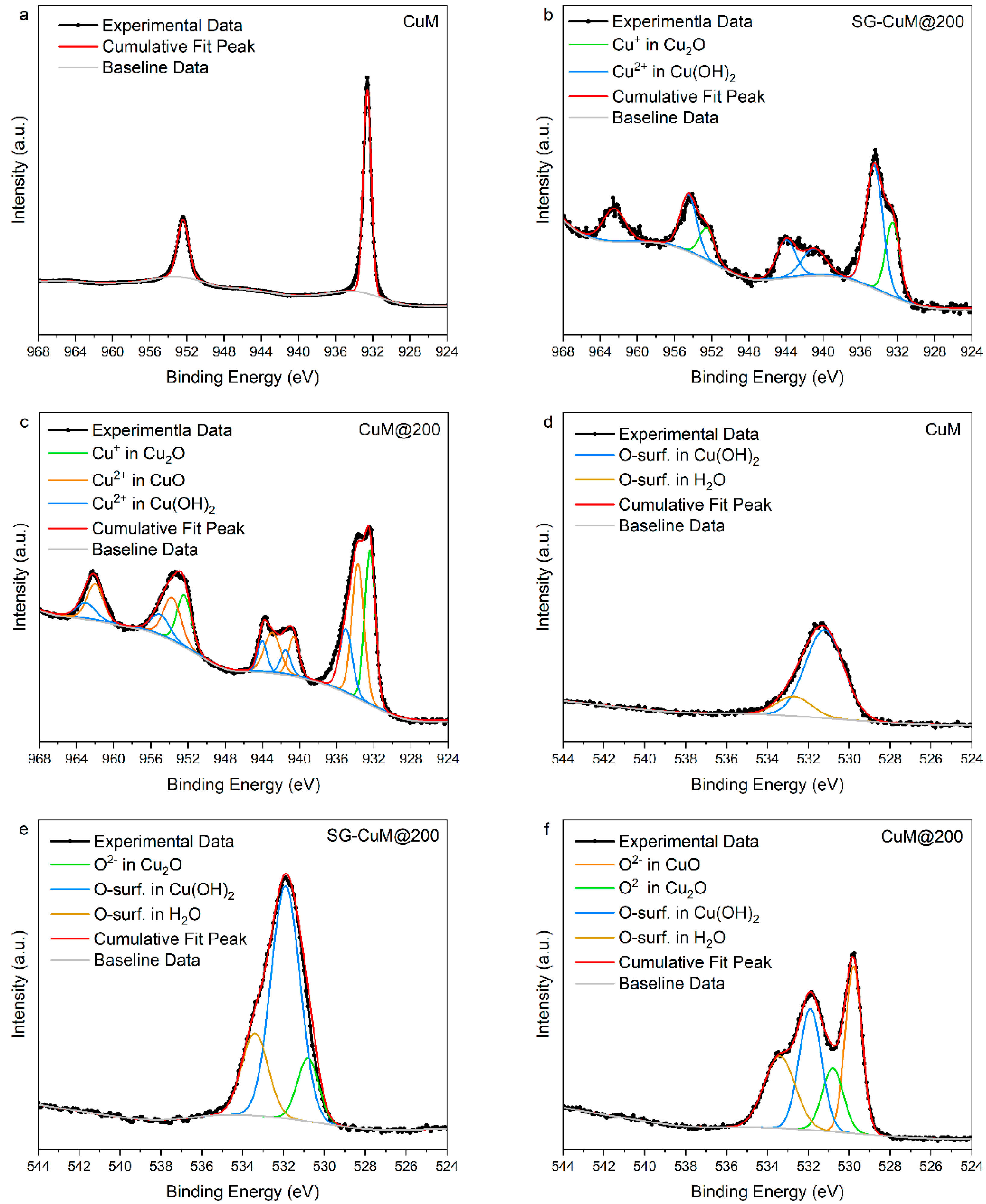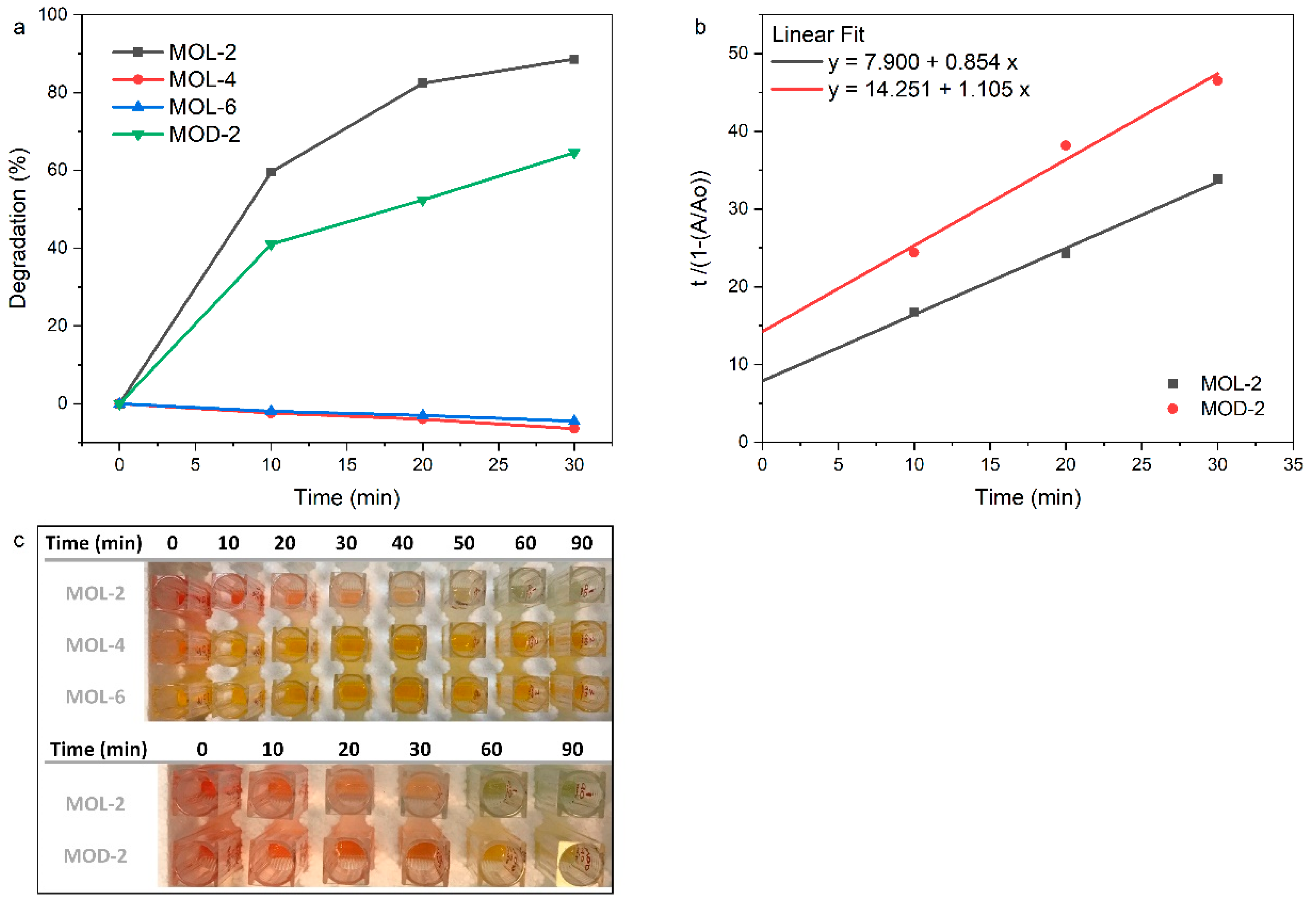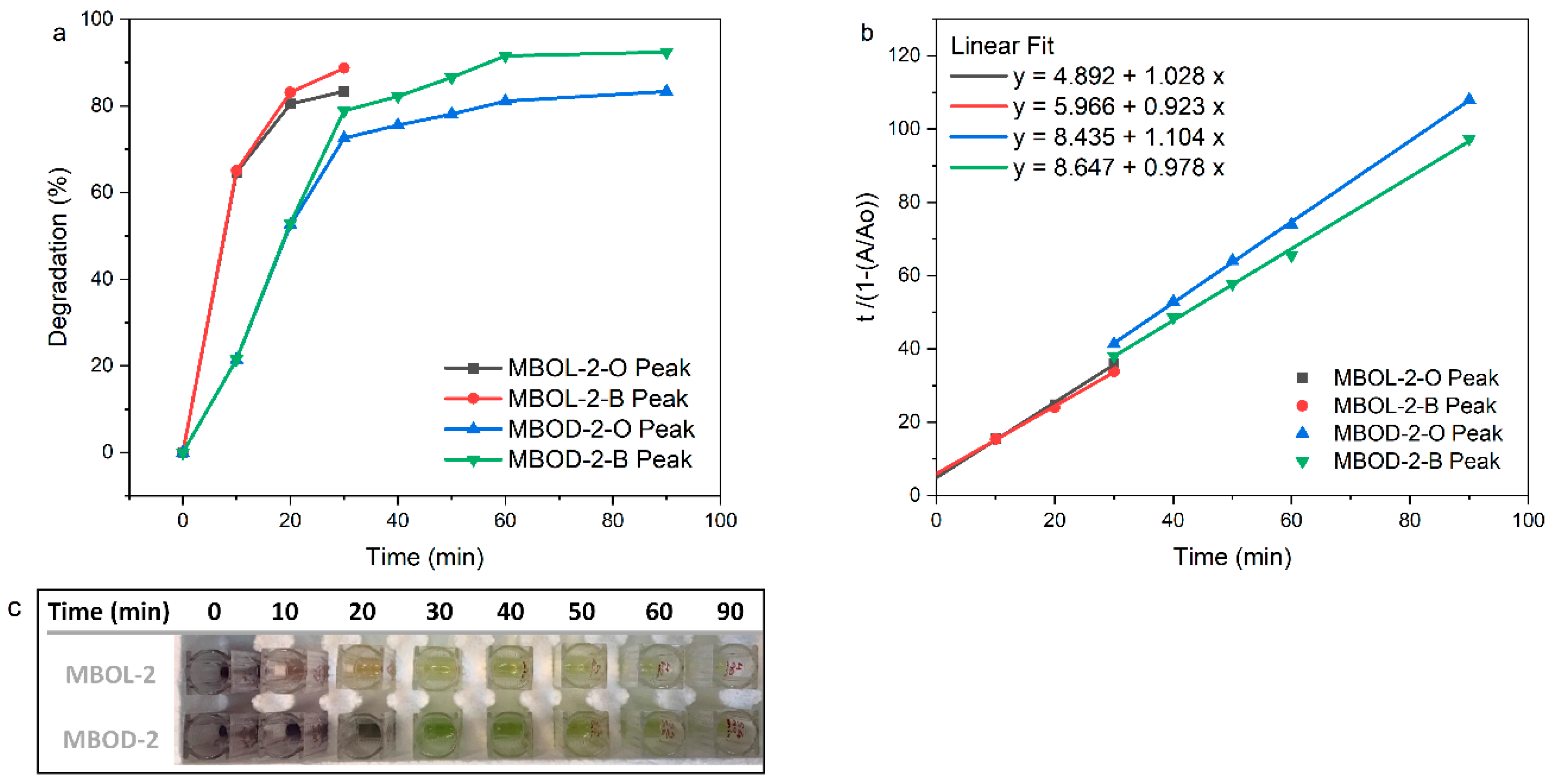Green Synthesized Cu2O-Cu(OH)2@Cu Nanocomposites with Fenton-like Catalytic Properties for the Degradation of Cationic and Anionic Dyes
Abstract
:1. Introduction
2. Materials and Methods
2.1. Catalysts Synthesis
2.2. Characterization Techniques
2.3. Catalytic Activity Measurements
3. Results and Discussion
3.1. Structural and Morphological Properties
3.2. Catalytic Activity Performance
3.2.1. Degradation of Cationic Methylene Blue (MB)
3.2.2. Degradation of Anionic Methyl Orange (MO)
3.2.3. Selective Degradation of (MB) and (MO)
4. Conclusions
5. Patents
Supplementary Materials
Author Contributions
Funding
Institutional Review Board Statement
Informed Consent Statement
Data Availability Statement
Conflicts of Interest
References
- Al-Tohamy, R.; Ali, S.S.; Li, F.; Okasha, K.M.; Mahmoud, Y.A.; Elsamahy, T.; Jiao, H.; Fu, Y.; Sun, J. A critical review on the treatment of dye-containing wastewater: Ecotoxicological and health concerns of textile dyes and possible remediation approaches for environmental safety. Ecotoxicol. Environ. Saf. 2022, 231, 113160. [Google Scholar] [CrossRef] [PubMed]
- Khan, I.; Saeed, K.; Zekker, I.; Zhang, B.; Hendi, A.H.; Ahmad, A.; Ahmad, S.; Zada, N.; Ahmad, H.; Shah, L.A.; et al. Review on Methylene Blue: Its Properties, Uses, Toxicity and Photodegradation. Water 2022, 14, 242. [Google Scholar] [CrossRef]
- Hussain, S.; Aneggi, E.; Goi, D. Catalytic activity of metals in heterogeneous Fenton-like oxidation of wastewater contaminants: A review. Environ. Chem. Lett. 2021, 19, 2405–2424. [Google Scholar] [CrossRef]
- Thangaraj, S.; Bankole, P.O.; Sadasivam, S.K. Microbial degradation of azo dyes by textile effluent adapted, Enterobacter hormaechei under microaerophilic condition. Microbiol. Res. 2021, 250, 126805. [Google Scholar] [CrossRef] [PubMed]
- Islam, A.; Teo, S.H.; Taufiq-Yap, Y.H.; Ng, C.H.; Vo, D.-V.N.; Ibrahim, M.L.; Hasan, M.M.; Khan, M.A.R.; Nur, A.S.M.; Awual, M.R. Step towards the sustainable toxic dyes removal and recycling from aqueous solution- A comprehensive review. Resour. Conserv. Recycl. 2021, 175, 105849. [Google Scholar] [CrossRef]
- Khan, S.; Sayed, M.; Sohail, M.; Shah, L.A.; Raja, M.A. Chapter 6—Advanced Oxidation and Reduction Processes. In Advances in Water Purification Techniques; Ahuja, S., Ed.; Elsevier: Amsterdam, The Netherlands, 2019; pp. 135–164. [Google Scholar] [CrossRef]
- Luo, B.; Liu, G.; Wang, L. Recent advances in 2D materials for photocatalysis. Nanoscale 2016, 8, 6904–6920. [Google Scholar] [CrossRef]
- Sadeghfar, F.; Ghaedi, M.; Zalipour, Z. Chapter 4—Advanced oxidation. In Interface Science and Technology; Ghaedi, M., Ed.; Elsevier: Amsterdam, The Netherlands, 2021; Volume 32, pp. 225–324. [Google Scholar]
- Walling, S.A.; Um, W.; Corkhill, C.L.; Hyatt, N.C. Fenton and Fenton-like wet oxidation for degradation and destruction of organic radioactive wastes. NPJ Mater. Degrad. 2021, 50, 1–20. [Google Scholar] [CrossRef]
- Dong, S.; Feng, J.; Fan, M.; Pi, Y.; Hu, L.; Han, X.; Liu, M.; Sun, J.; Sun, J. Recent developments in heterogeneous photocatalytic water treatment using visible light-responsive photocatalysts: A review. RSC Adv. 2015, 5, 14610–14630. [Google Scholar] [CrossRef]
- Meyer, B.; Polity, A.; Reppin, D.; Becker, M.; Hering, P.; Klar, P.J.; Sander, T.; Reindl, C.; Benz, J.; Eickhoff, M.; et al. Binary copper oxide semiconductors:From materials towards devices. Phys. Status Solidi B 2012, 249, 1487–1509. [Google Scholar] [CrossRef]
- Sun, S. Recent advances in hybrid Cu2O-based heterogeneous nanostructures. Nanoscale 2015, 7, 10850–10882. [Google Scholar] [CrossRef]
- Al-Jawhari, H.; Al-Murashi, R.; Abu Saba, L.; Alhebshi, N.; Altuwirqi, R. Effective degradation of MB under natural daylight using green synthesized Cu-Cu2O composite films. Mater. Lett. 2019, 254, 233–236. [Google Scholar] [CrossRef]
- Alhebshi, N.; Huang, H.; Ghandour, R.; Alghamdi, N.K.; Alharbi, O.; Aljurban, S.; He, J.-H.; Al-Jawhari, H. Green synthesized CuxO@Cu nanocomposites on a Cu mesh with dual catalytic functions for dye degradation and hydrogen evaluation. J. Alloys Compd. 2020, 848, 156284. [Google Scholar] [CrossRef]
- Murugadoss, G.; Rajesh Kumar, M.; Kuppusami, P. Synthesis of Cu2O-Cu(OH)2 nanocomposite from CuSCN precursor by a facile chemical precipitation method. Mater. Lett. 2021, 284, 128866. [Google Scholar] [CrossRef]
- Hu, L.; Wang, Z.; Hu, Y.; Liu, Y.; Zhang, S.; Zhou, Y.; Zhang, Y.; Liu, Y.; Li, B. The preparation of Janus Cu(OH)2@Cu2O/Cu mesh and application in purification of oily wastewater. Mater. Res. Bull. 2020, 126, 110815. [Google Scholar] [CrossRef]
- Mamba, G.; Pulgarin, C.; Kiwi, J.; Bensimon, M.; Rtimi, S. Synchronic coupling of Cu2O(p)/CuO(n) semiconductors leading to Norfloxacin degradation under visible light. J. Catal. 2017, 353, 133–140. [Google Scholar] [CrossRef]
- Sun, B.; Li, H.; Li, X.; Liu, X.; Zhang, C.; Xu, H.; Zhao, X.S. Degradation of Organic Dyes over Fenton-Like Cu2O–Cu/C Catalysts. Ind. Eng. Chem. Res. 2018, 57, 14011–14021. [Google Scholar] [CrossRef]
- Wang, G.; Li, G.; Huan, Y.; Hao, C.; Chen, W. Acrylic acid functionalized graphene oxide: High-efficient removal of cationic dyes from wastewater and exploration on adsorption mechanism. Chemosphere 2020, 261, 127736. [Google Scholar] [CrossRef] [PubMed]
- Salleh, M.A.M.; Mahmoud, D.K.; Karim, W.A.W.A.; Idris, A. Cationic and anionic dye adsorption by agricultural solid wastes: A comprehensive review. Desalination 2011, 280, 1–13. [Google Scholar] [CrossRef]
- Zheng, J.Y.; Van, T.-K.; Pawar, A.U.; Kim, C.W.; Kang, Y.S. One-step transformation of Cu to Cu2O in alkaline solution. RSC Adv. 2014, 4, 18616–18620. [Google Scholar] [CrossRef]
- Liu, Y.; Chu, Y.; Li, M.; Li, L.; Dong, L. In situ synthesis and assembly of copper oxide nanocrystals on copper foil via a mild hydrothermal process. J. Mater. Chem. 2006, 16, 192–198. [Google Scholar] [CrossRef]
- Behnajady, M.A.; Modirshahla, N.; Ghanbary, F. A kinetic model for the decolorization of C.I. Acid Yellow 23 by Fenton process. J. Hazard. Mater. 2007, 148, 98–102. [Google Scholar] [CrossRef] [PubMed]
- Santana, C.S.; Nicodemos Ramos, M.D.; Vieira Velloso, C.C.; Aguiar, A. Kinetic Evaluation of Dye Decolorization by Fenton Processes in the Presence of 3-Hydroxyanthranilic Acid. Int. J. Environ. Res. Public Health 2019, 16, 1602. [Google Scholar] [CrossRef] [PubMed]
- National Institute of Standards and Technology. NIST X-ray Photoelectron Spectroscopy Database; National Institute of Standards and Technology: Gaithersburg, MD, USA, 2000; Volume 20899.
- Moulder, J.F. Standard XPS Spectra for Elements. In Handbook of X-ray Photoelectron Spectroscopy: A Reference Book of Standard Spectra for Identification and Interpretation of XPS Data, 1st ed.; Chastain, J., Ed.; Perkin-Elmer Corporation: Eden Prairie, MN, USA, 1992. [Google Scholar]
- Biesinger, M.C. Advanced analysis of copper X-ray photoelectron spectra. Surf. Interface Anal. 2017, 49, 1325–1334. [Google Scholar] [CrossRef]
- Zhu, G.; Jin, Y.; Ge, M. Simple and green method for preparing copper nanoparticles supported on carbonized cotton as a heterogeneous Fenton-like catalyst. Colloids Surf. A Physicochem. Eng. Asp. 2022, 647, 128978. [Google Scholar] [CrossRef]
- Dong, C.; Zhong, M.; Huang, T.; Ma, M.; Wortmann, D.; Brajdic, M.; Kelbassa, I. Photodegradation of methyl orange under visible light by micro-nano hierarchical Cu2O structure fabricated by hybrid laser processing and chemical dealloying. ACS Appl. Mater. Interfaces 2011, 3, 4332–4338. [Google Scholar] [CrossRef]
- Dong, G.; Ai, Z.; Zhang, L. Total aerobic destruction of azo contaminants with nanoscale zero-valent copper at neutral pH: Promotion effect of in-situ generated carbon center radicals. Water Res. 2014, 66, 22–30. [Google Scholar] [CrossRef]
- Abdulrahman Hanoon, M.; Ahmed, M.J. Adsorption of Methyl Orange from Wastewater by using Biochar. Iraqi J. Chem. Pet. Eng. 2019, 20, 23–29. [Google Scholar] [CrossRef]
- Sha, Y.; Mathew, I.; Cui, Q.; Clay, M.; Gao, F.; Zhang, X.J.; Gu, Z. Rapid degradation of azo dye methyl orange using hollow cobalt nanoparticles. Chemosphere 2016, 144, 1530–1535. [Google Scholar] [CrossRef]
- Trotte, N.S.F.; Aben-Athar, M.T.G.; Carvalho, N.M.F. Yerba Mate Tea Extract: A Green Approach for the Synthesis of Silica Supported Iron Nanoparticles for Dye Degradation. J. Braz. Chem. Soc. 2016, 27, 2093–2104. [Google Scholar] [CrossRef]
- Li, H.; Su, Z.; Hu, S.; Yan, Y. Free-standing and flexible Cu/Cu2O/CuO heterojunction net: A novel material as cost-effective and easily recycled visible-light photocatalyst. Appl. Catal. B 2017, 207, 134–142. [Google Scholar] [CrossRef]
- Baghriche, O.; Rtimi, S.; Pulgarin, C.; Kiwi, J. Polystyrene CuO/Cu2O uniform films inducing MB-degradation under sunlight. Catal. Today 2017, 284, 77–83. [Google Scholar] [CrossRef]
- Kamazani, M.; Zarghami, Z.; Rahmatolahzadeh, R.; Ramezani, M. Solvent free synthesis of Cu-Cu2O nanocomposites via green thermal decomposition route. Adv. Powder Technol. 2017, 28, 2078–2086. [Google Scholar] [CrossRef]
- Xu, L.; Srinivasakannan, C.; Peng, J.; Zhang, L.; Zhang, D. Synthesis of Cu-CuO nanocomposite in microreactor and its application to photocatalytic degradation. J. Alloys Compd. 2017, 695, 263–269. [Google Scholar] [CrossRef]
- Jiang, D.; Xue, J.; Wu, L.; Zhou, W.; Zhang, Y.; Li, X. Photocatalytic performance enhancement of CuO-Cu2O heterostructures for photodegradation of organic dyes—Effects of CuO morphology. Appl. Catal. B 2017, 211, 199–204. [Google Scholar] [CrossRef]






| Sample | BMG | First-Order | Second-Order | ||||
|---|---|---|---|---|---|---|---|
| 1/m (min−1) | 1/b | R2 | K1 (min−1) | R2 | K2 (mg−1 min−1) | R2 | |
| MBL-11 | 0.09451 | 0.99285 | 0.99739 | 0.02299 | 0.88911 | 0.06369 | 0.98638 |
| MBL-9 | 0.08126 | 0.97133 | 0.99730 | 0.02011 | 0.83615 | 0.04422 | 0.95285 |
| MBL-6.5 | 0.05466 | 0.84792 | 0.99918 | 0.01336 | 0.85724 | 0.01803 | 0.95686 |
| MBL-2 | 0.06145 | 1.05001 | 0.99123 | 0.0228 | 0.88867 | 0.05304 | 0.92921 |
| MBD-2 | 0.04431 | 1.23779 | 0.98668 | 0.02860 | 0.95796 | 0.0825 | 0.94967 |
| Control Sample | 0.00118 | 0.83838 | 0.02102 | 0.00134 | 0.91223 | 8.89 × 10−4 | 0.90903 |
| Sample | BMG | First-Order | Second-Order | ||||
|---|---|---|---|---|---|---|---|
| 1/m (min−1) | 1/b | R2 | K1 (min−1) | R2 | K2 (mg−1 min−1) | R2 | |
| MOL-2 | 0.1265 | 0.9046 | 0.9949 | 0.0735 | 0.9779 | 0.1890 | 0.9770 |
| MOD-2 | 0.0701 | 0.9046 | 0.9802 | 0.0332 | 0.9628 | 0.0412 | 0.9895 |
| MOL-4 | −0.0024 | −0.3662 | 0.3800 | −0.0020 | 0.9933 | −0.0023 | 0.9929 |
| MOL-6 | −0.0021 | −0.1303 | 0.7934 | −0.0014 | 0.9864 | −0.0016 | 0.9852 |
| Sample | BMG | First-Order | Second-Order | ||||
|---|---|---|---|---|---|---|---|
| 1/m (min−1) | 1/b | R2 | K1 (min−1) | R2 | K2 (mg−1 min−1) | R2 | |
| MBOL-2-O Peak | 0.20441 | 0.97327 | 0.99756 | 0.05964 | 0.90114 | 0.22334 | 0.97356 |
| MBOL-2-B Peak | 0.16763 | 1.08389 | 0.99889 | 0.07269 | 0.96155 | 0.34561 | 0.98960 |
| MBOD-2-O Peak | 0.11858 | 1.08389 | 0.99969 | 0.00747 | 0.91776 | 0.05371 | 0.94129 |
| MBOD-2-B Peak | 0.11565 | 1.0221 | 0.99771 | 0.01621 | 0.76927 | 0.17357 | 0.80569 |
Publisher’s Note: MDPI stays neutral with regard to jurisdictional claims in published maps and institutional affiliations. |
© 2022 by the authors. Licensee MDPI, Basel, Switzerland. This article is an open access article distributed under the terms and conditions of the Creative Commons Attribution (CC BY) license (https://creativecommons.org/licenses/by/4.0/).
Share and Cite
Al-Jawhari, H.A.; Alhebshi, N.A. Green Synthesized Cu2O-Cu(OH)2@Cu Nanocomposites with Fenton-like Catalytic Properties for the Degradation of Cationic and Anionic Dyes. Crystals 2022, 12, 1328. https://doi.org/10.3390/cryst12101328
Al-Jawhari HA, Alhebshi NA. Green Synthesized Cu2O-Cu(OH)2@Cu Nanocomposites with Fenton-like Catalytic Properties for the Degradation of Cationic and Anionic Dyes. Crystals. 2022; 12(10):1328. https://doi.org/10.3390/cryst12101328
Chicago/Turabian StyleAl-Jawhari, Hala A., and Nuha A. Alhebshi. 2022. "Green Synthesized Cu2O-Cu(OH)2@Cu Nanocomposites with Fenton-like Catalytic Properties for the Degradation of Cationic and Anionic Dyes" Crystals 12, no. 10: 1328. https://doi.org/10.3390/cryst12101328





